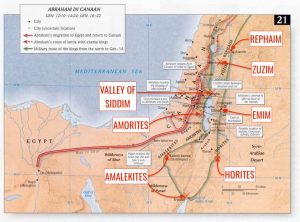A WAR fought near the Dead Sea nearly 4,000 years ago is the focus of this week’s study.
After Abram arrived in Canaan and settled near Hebron, his nephew Lot was captured by an army from Mesopotamia that had come to put down a rebellion by the king of Sodom and his allies. We discuss the meanings of the names of the rebel kings, the possible identities of the kings of the east, and the significance of the Rephaim tribes defeated by the kings of Mesopotamia.
We also discuss Melchizedek (malki-tsedeq, “my king is righteous” or “king of righteousness”), the king of Salem, who greeted Abram upon his return from rescuing Lot and the other captives from Sodom. Was he the incarnate Christ, as some believe? We think not, but it’s a question that’s still debated after 2,000 years, and we note the link between Jesus and Melchizedek in Hebrews chapter 7.
The historical details provided by the Bible are consistent with the political situation in Mesopotamia in the early years of the reign of Hammurabi of Babylon, who may be the Amraphel of Shinar mentioned in Genesis 14. About 30 years into his reign, Hammurabi went to war with Elam, driving that kingdom out of the plains of Sumer, and then turned on his southern neighbor, Larsa (Ellasar), for not supporting Babylon in its war against their Elamite overlords.
So, the events of Genesis 14 took place after Hammurabi ascended to the throne of Babylon but before his war with Elam. Chronologies of Mesopotamia variously date Hammurabi’s reign to 1848-1806 BC (High Chronology), 1792-1750 BC (Middle Chronology), or 1728-1686 BC (Low Chronology). The High Chronology fits best with the timeline of the Bible, which places Abram in Canaan by 1876 BC
Note that since we studied this chapter in January of 2015, we’ve changed our minds about some things. Specifically:
- Amraphel of Shinar may have been Hammurabi of Babylon
- Ellasar most likely refers to the city-state of Larsa, a rival of Babylon that was conquered by Hammurabi around 1763 BC
- Tidal of Goiim was probably a leader of the Gutians, a barbaric people from the mountains of northwest Iran
- Sodom and the cities of the plain were not located southeast of the Dead Sea, but northeast, within sight of Jericho and Mount Nebo, at an archaeological site called Tall el-Hammam.
To find out more about the evidence for identifying Tall el-Hammam in Jordan as ancient Sodom, log on to www.DigSodom.com, and listen to Derek’s interview with Dr. Phillip Silvia, part of the archaeological team excavating at Tall el-Hammam.
Click here for the complete archive of our New Testament Bible studies to date, and click here for the Old Testament studies to date. Or go to www.spreaker.com/show/gilbert-house-fellowship for all of the audio.


Mahalo from Hawaii.
I love the Sundays fellowship and teaching.
I have been following both of you for a long time and watch Sky Watch TV.
Thank you for all you do and your hard work.
a hui hoe
Bo
I always wondered why Sam T Dachshund? Does the T stand for Tiberius?
I always thought it was for “The,” but Sharon and Sam confirmed that his full name was, in fact, Samwise Tiberius Dachshund.
Tolkien meets Star Trek makes great fan-fiction. Our first cat here was feral and called Tommy but we decided his Indian name, after watching Dancing with Wolves, was Head-in-a Trough. It’s great learning about the way people and places are named as it is so important in many cultures. Jewish friends and I were discussing Yeshua a number of weeks ago. Very interesting.
Wouldn’t Avram had plenty of donkeys, mules and horses so they could move faster than 15 miles a.day? Avram was very wealthy.
Here’s my educated guess: donkeys & mules would have carried the tents & supplies, horses would be used for scouting (for watering holes & potential threats). Mainly the people would have walked, so 15 miles/day is about right. The Spanish missions on the California coast are spaced 20 miles apart, which was a day’s walk for the monks and most travelers, as it’s not a barren desert.
So thankful for this Sunday study. It helped to turn my mind from C.V. to the Bible. I stayed home from Church so your study was a great Blessing to me.
Sherry